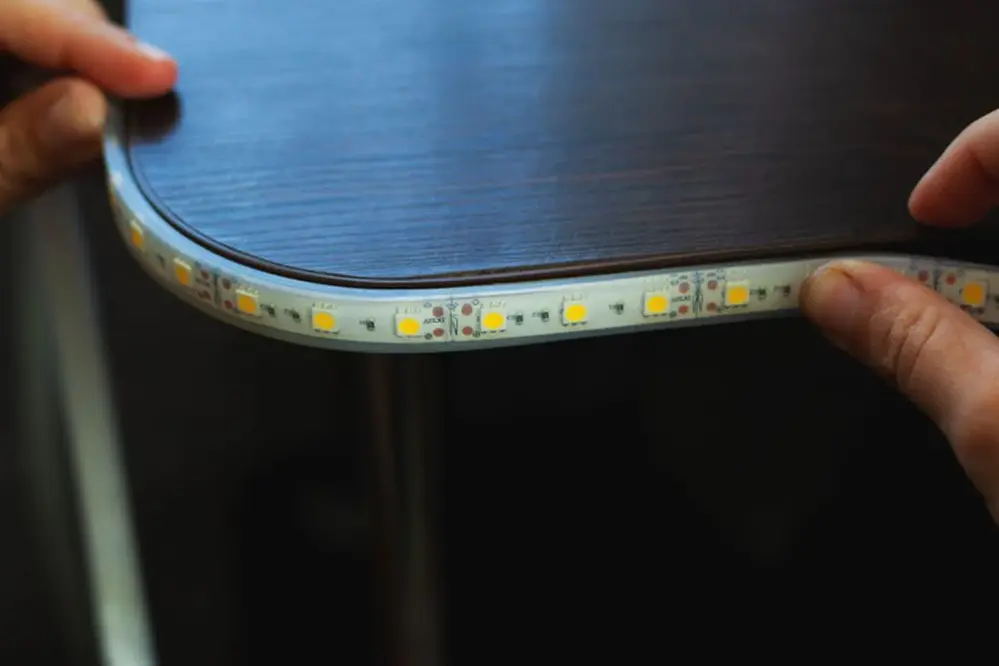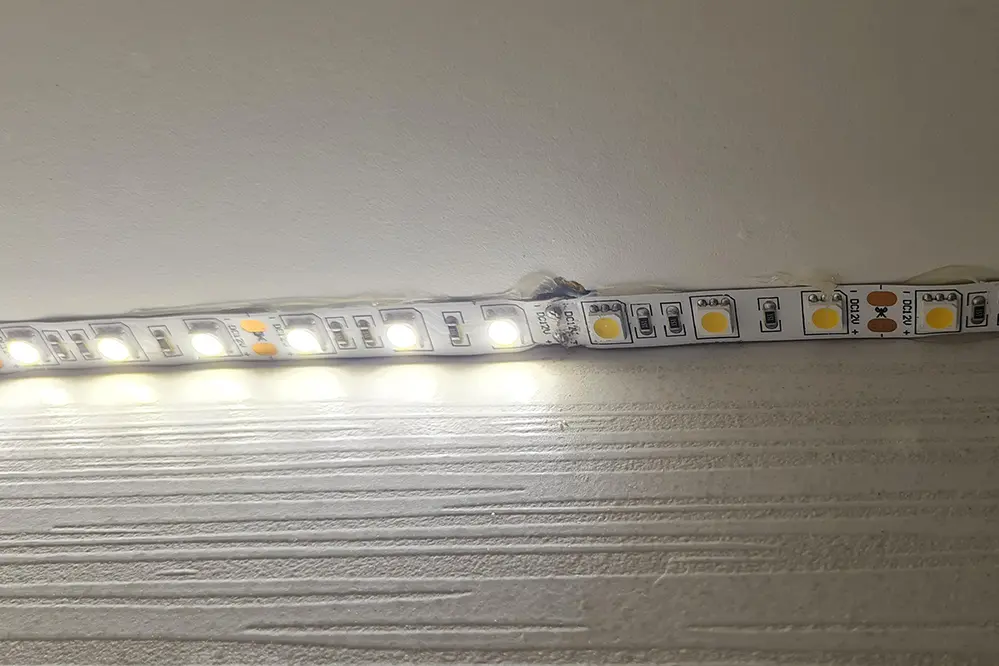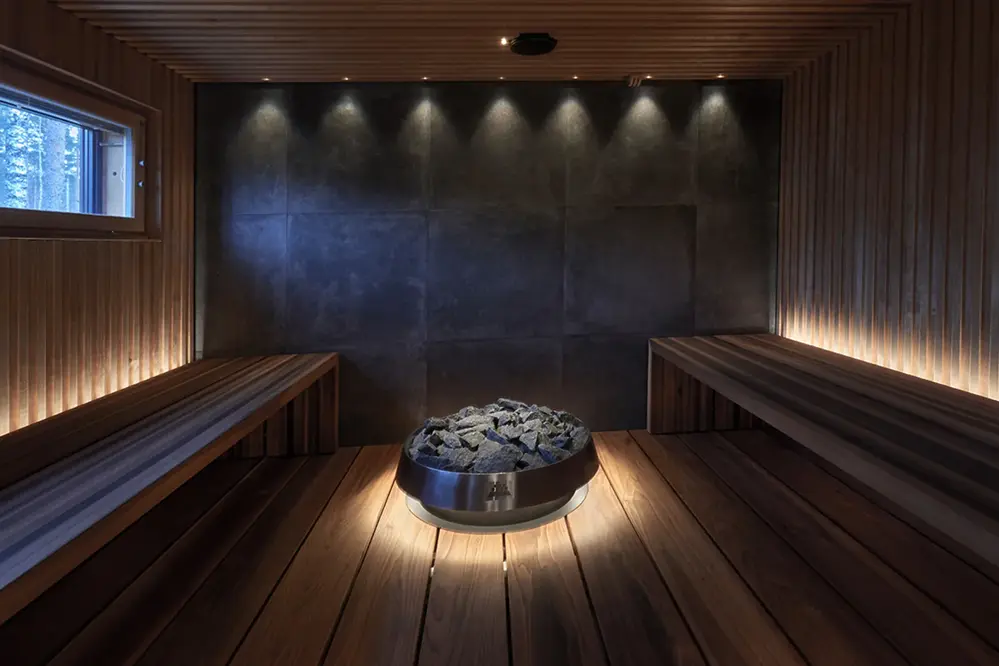Are you wondering if you can bend LED strip lights? Look no further! We have the answer you’ve been searching for.
Yes, you can bend LED strip lights to create stunning lighting designs. Discover the techniques, considerations, and tips to achieve flexible lighting solutions that will elevate your projects.
In this blog post, we’ll delve into the world of bending LED strip lights, providing you with expert insights and practical advice. Whether you’re a lighting enthusiast or a professional, this guide will equip you with the knowledge to unleash your creativity and transform any space with flexible lighting solutions.
Understanding LED Strip Flexibility
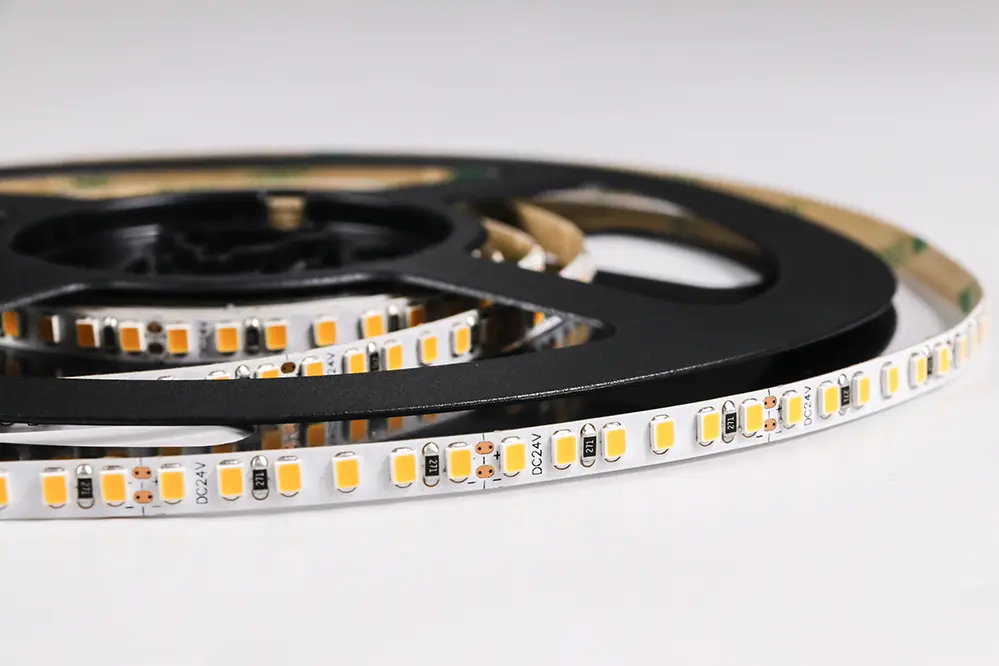
LED strip lights are inherently designed to be flexible, but the degree of bendability can vary significantly based on their construction and the materials used. This intrinsic flexibility allows the strips to conform to different shapes and surfaces for versatile lighting solutions.
While most LED strips can be bent to a degree, pushing them beyond their designed curvature can cause stress on the circuitry. Uniform and gentle bending around wide curves maintains the integrity of the LEDs and the solder points, a prerequisite for dependable operation and longevity.
It’s essential to distinguish between “side-bending” and “up-bending” strips. Each type accommodates specific axis bending and should be chosen accordingly to fit the contours of your design without inducing stress or damage.
Types of LED Strips
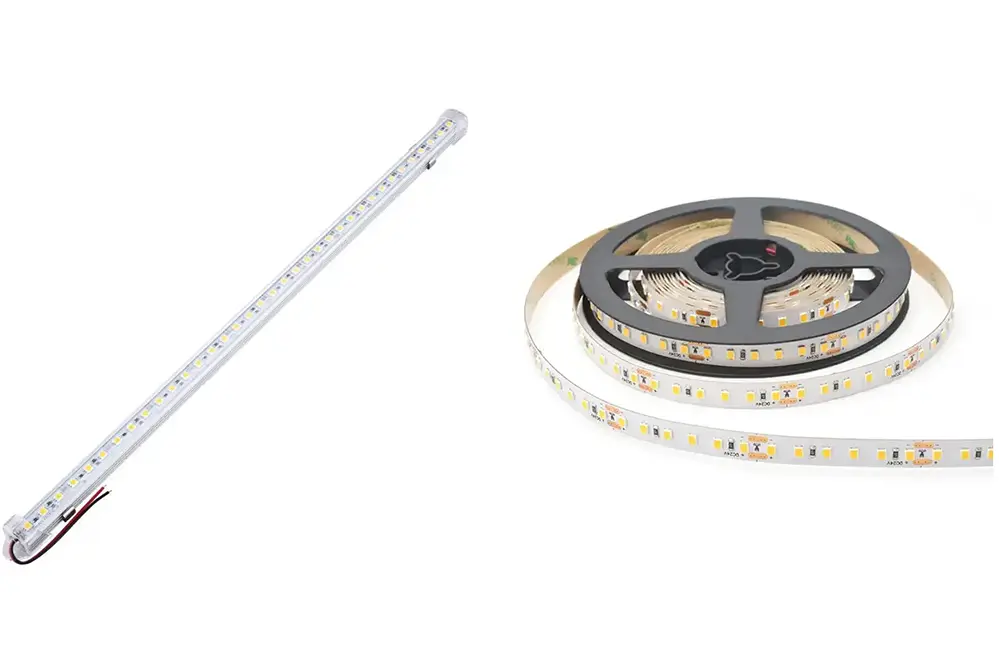
LED strips come in myriad forms, each suited to specific applications and bending capabilities that enable various levels of customization.
LED strip lights use energy efficiently, often leading to notable reductions in electricity bills compared to traditional lighting.
With categories ranging from single-color, tunable white, to RGB and RGBW variants, selection largely depends on the intended lighting effect and flexibility required for installation.
High-density LED strips offer intense illumination and minimal spotting, whereas low-density strips provide a more diffused light ideal for accent or indirect lighting scenarios.
Flexible vs. Rigid Materials
The composition of LED strip materials determines their flexibility and application potential.
- Flexible PCBs are typically made with thin, bendable layers of copper that can conform to curved surfaces.
- Rigid substrates, such as fiberglass, maintain shape and are suited for straight applications.
- Adhesive backing adds to the ease of installation for flexible strips, allowing for secure placement on various surfaces.
- Silicone coatings can protect flexible LED strips, enhancing their longevity and durability.
These distinct materials may drastically influence the bending radius.
LED strip lights crafted with flexible materials are more versatile, facilitating intricate designs and creative lighting solutions.
On the contrary, rigid LED strips ensure structural stability and are optimal for linear lighting installations that do not require bending.
Bending Limits
LED strip lights, by design, allow for bending to a certain extent.
While LED strips are indeed flexible, there is a critical maximum bending radius that must be respected to avoid damaging the strip’s circuitry. Forcing a strip beyond this limit can break internal connections, leading to a loss of function or, at the very least, inconsistent illumination along the strip. This is particularly crucial at the points where LEDs are mounted and where the strip’s electrical traces are the most vulnerable.
Additionally, the type of LED strip impacts its bending capabilities. Standard LED strips with a flexible printed circuit board (PCB) can be bent along the axis of the LEDs without risk, as long as the bending action is gradual and does not crease the PCB. However, strips designed with surface-mounted diodes (SMD) placed very closely may exhibit less flexibility due to tighter spacing, warranting careful manipulation to prevent damage.
Furthermore, repeated bending may fatigue the materials, causing wear over time. While initially a bend might be executed with success, the repetitive adjusting of the same section could eventually lead to a failure in the strip’s structural integrity. This is why planning your installation to minimize the need for future adjustment is critical for the longevity of the lighting system.
In summary, while LED strip lights are designed for versatility, it is imperative to understand the inherent limits of their construction. Bends should be within specified radii, performed with care, and avoided altogether in more densely packed SMD configurations. When planning a layout, consider the bending limitations to ensure a reliable and visually appealing result while also extending the operational life of your LED strip lighting.
Preparing for LED Strip Installation
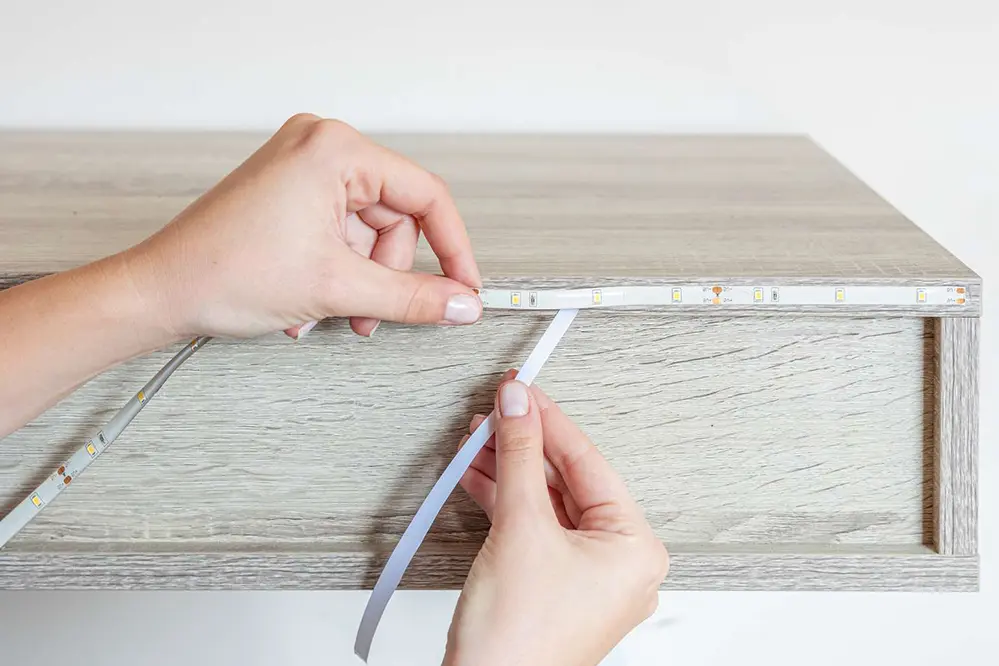
Prior to commencing the installation of LED strip lights, ensure that you have all the requisite materials and tools at hand. Any surface intended for strip placement must be cleaned thoroughly, removing all debris, dust, or oil, as these contaminants can significantly hinder the adhesion process. A clean, dry, and flat surface is fundamental to a successful installation.
Careful measurement and planning cannot be overstated in the preparation phase. Accurate cuts and strategic placement of LED strips will influence both the aesthetic outcome and the functional integrity of the lighting setup. Therefore, it is wise to meticulously mark the intended paths before any strips are affixed in place.
Measuring and Planning
Precise measurement is foundational for the successful installation of LED strip lights.
- Determine the Total Length: Measure the area where the strip will be installed to ascertain the total length needed.
- Account for Obstacles: Identify any corners, edges, or surface irregularities that may influence the layout.
- Plan Bends and Angles: Establish where the strip needs to bend to conform to the installation surface contours.
- Decide on Cutting Points: Locate the designated cutting points on the strip to ensure proper segment lengths.
Anticipate the necessary bends to avoid compromising the LEDs’ functionality.
Careful foresight in planning ensures seamless continuity and optimal light distribution.
Surface Preparation
Before attempting to bend LED strip lights, surface preparation is paramount.
- Clean the Surface: Ensure that the installation area is free of dust, dirt, and oils to promote maximum adhesion.
- Dry Completely: After cleaning, the surface must be fully dry to prevent any moisture from weakening the adhesive bond.
- Test Fit the Strip: Before removing any backing, place the LED strip along its intended path to confirm fit and alignment.
- Mark Alignment Points: Using a pencil or non-permanent marker, lightly mark where the strip will lay to facilitate precise application.
- Ensure a Flat Profile: For surfaces that aren’t inherently flat, use fillers or create a smooth substrate to avoid uneven light distribution and potential damage.
Without proper surface preparation, the longevity and stability of the LED strip could be jeopardized.
Proper adhesion is critical when incorporating bends into your design, as stress points can lead to strip failure.
Cutting and Connecting Points
LED strip lights are designed with specific cutting and connecting points, which are indicated by lines or scissor icons.
- Scissor icons signify where the strip may be cut.
- Copper pads exist at each cutting point for soldering or clip-on connectors.
- Manufacturer guidelines should be followed to maintain warranty and ensure proper operation.
- Cutting between points can result in damage and loss of functionality.
It is crucial to cut only at these designated points to retain strip integrity and functionality.
Modifying LED strips outside of these points could void any warranty and potentially cause irreparable harm to the lighting system.
Techniques for Bending LED Strips
To successfully navigate the intricacies of bending LED strip lights, especially at sharp angles, manual techniques should be complemented with precision and care. Utilizing the inherent flexibility of the strips, one should gently guide and contour them around desired corners or curves, while ensuring that no undue stress is exerted on the soldered connections and electronic components. Care is paramount, as excessive force can sever circuits or compromise the LED’s performance.
Preformed profiles or channel systems can also facilitate an effective bending process. These specialized accessories are engineered to support and maintain the curvature of LED strips without causing any detrimental kinks or strain. When selecting such aids, always consider compatibility with the specific dimensions and flexibility of the LED strip to achieve a seamless and reliable installation.
Safe Bending Angles
LED strips are designed with certain limitations regarding how sharply they can be bent without damage. To maintain the integrity and performance of LED strip lights, one should adhere to the manufacturer-provided bending radius specifications. Exceeding these specified angles jeopardizes the functional longevity of the strips.
A conservative approach is to avoid bending LED strips at angles less than 90 degrees. Such acute angles can strain the strip’s circuitry and lead to failure.
When bending LED strip lights, evaluate the individual LED spacing and strip width to determine a safe bending radius. It is generally safer to bend the strips with the LEDs facing outward, creating a larger radius that reduces the risk of damaging the internal components or disrupting the LED sequence.
It is pertinent to acknowledge the varying flexibility across different LED strip products. The construction materials, width of the PCB (Printed Circuit Board), and type of LED chips employed dictate the permissible bending angles. In scenarios of uncertainty, consulting documentation or reaching out to the manufacturer for guidance on safe bending practices ensures a successful and enduring installation. Overextending the strip beyond its mechanical limits could compromise its structural integrity, resulting in a malfunction or a noticeable decline in light quality.
Heat-Assisted Bending
Flexible illumination reinvents spatial design.
Innovative shaping through heat unlocks new horizons in LED strip flexibility. Controlled application of warmth allows for more acute modifications in strip curvature, essential for achieving bespoke lighting solutions. Symmetrical heat distribution ensures the integrity of the strip’s components, whereas uneven application can provoke malfunctions.
Heat-assisted techniques must respect material thresholds.
Utilizing a carefully monitored heating process – such as a dedicated heat gun or specialized warming device – facilitates the compliant shaping of LED strips. This technique, known as heat-assisted bending, modifies the strip’s pliability, making precise adjustments possible without compromising electronic functionality.
LED segments conform when thermally persuaded.
Heat-assisted bending requires a nuanced understanding of thermal properties and patience. Excessive temperatures or prolonged exposure risk not only the aesthetic but also the electrical architecture of the strip. Thus, a balance between adequate flexibility and ensuring structural coherence is critical when employing heat-assisted bending techniques.
Meticulous heat application promises luminous innovation.
The evolution of heat-assisted bending as a technique is indicative of the industry’s commitment to expanding the versatility of LED lighting solutions. As we approach the later quarters of 2023, this method continues to gain traction among professionals seeking to shape light to match complex contours and architectural details. Integrating such innovation, however, demands a scrupulous approach to temperature control and a clear understanding of each strip’s material composition.
Avoiding Common Mistakes
Uneven bending can compromise LED strips’ integrity and function, making precise preparation and measurement critical for successful contouring around curves. The technique demands a careful approach to avoid compromising the delicate components within the strip.
Do not ignore the maximum bend radius specified by the manufacturer. Exceeding this limit could irreparably damage the strip.
Improperly applied heat can warp or melt the LED strip, destroying both its appearance (affecting the diffusion of light) and functionality.
When bending LED strip lights, be wary of compromising the circuitry within. The internal components are delicate and can be damaged by exerting too much force.
Ensure that the LED strip is firmly secured before attempting to bend it. Inadequately anchoring the strip could lead to inconsistent bends and potential damage to both the strip and the surface to which it is being affixed.
Lastly, it is crucial to test the LED strip’s functionality post-bending. Carefully inspect and power the strip to identify any potential disruptions in the electrical continuity or lighting performance.
Maintenance and Durability Concerns
Even with meticulous application, the structural stress imposed on LED strip lights during bending can have long-term repercussions on their longevity. Regular inspections are essential to ascertain the integrity of soldered connections and the embedded ICs, which may have been inadvertently stressed. Furthermore, environmental factors like moisture and temperature fluctuations could exacerbate potential weaknesses caused by the bending process, leading to premature failure of the LED strip.
The resilience of the protective coating on the LED strip is also a vital aspect of its durability after bending. If the coating is compromised, it exposes the strip to dust and moisture, which can quickly degrade the LEDs and their circuitry. It is imperative, therefore, to handle the strips with care during installation and to ensure that any protective sealant displaced during the bending process is appropriately restored.
Waterproofing Considerations
Water resistance varies among LED strips.
Many LED strip lights feature an IP rating that asserts their level of protection against ingress from moisture and particulate matter. For applications that demand bending, selecting an LED strip with a high IP rating, such as IP65 or above, is critical to maintain water resistance despite the physical manipulation. However, even with high IP-rated strips, caution must be exercised during bending to prevent compromising the protective seal.
Bending compromises strip lights’ water resistant integrity.
When bending LED strips, it’s essential to not overstrain the waterproof coating or casing. Typically, the strips are encased in a silicone sleeve or coated with a water-resistant material. However, excessive bending may cause the enclosure or coating to crack or stretch, potentially allowing moisture to penetrate and damage the LEDs and circuitry.
Seal ends and connections for full protection.
After bending and cutting LED strips to size, it’s paramount to properly seal the ends and any connections. Sealing is often done with specialized end caps and sealant adhesives to restore the integrity of the strip’s waterproof barrier. Failure to do so could result in water ingress and eventual malfunction or failure of the LED strip.
Avoid sharp angles to prevent water ingress.
During installation, the recommended bending radius – usually specified by the manufacturer – should be adhered to in order to avoid creating crevices or gaps that could compromise the strip’s water resistance. Moreover, while bending waterproof LED strips, it is advisable to use specialized connectors that facilitate turns without physically bending the strip, thereby maintaining the integrity of the waterproof seal.
Consult the latest standards and ensure compliance.
Staying abreast of industry standards and regulations regarding waterproof LED installations becomes increasingly crucial, especially with the advancements in LED technology and changes in regulations governing lighting fixtures. As of early 2023, for example, careful consideration of the revised guidelines by regulatory bodies can assist in ensuring that bent LED strips are safely and effectively protected against water ingress for their intended application.
Long-Term Flexibility Retention
LED strip lights are renowned for their bendable nature, but maintaining flexibility over time requires understanding the materials’ capabilities and limits. Constant bending or flexing can stress the strips, potentially leading to a reduced ability to retain their shape and functionality.
The materials used in LED strips, typically a combination of flexible circuit boards and elastomeric coatings, are designed for a certain degree of pliability. Over time, however, these materials can become more brittle and lose their original flexibility, especially when subjected to repeated bending or environmental stressors like heat and UV radiation. This emphasizes the importance of considering the operating environment in conjunction with bending practices.
It’s imperative that the bending radius recommended by manufacturers is respected not only during the initial installation but throughout the lifespan of the LED strip. Exceeding this radius can accelerate the fatigue of material components, diminishing their ability to spring back to the intended form after bending.
Consequently, when planning for the longevity of a bent LED installation, it’s prudent to integrate maintenance and inspection schedules that encompass monitoring the mechanical flexibility of the strips. Ensuring that bends remain within manufacturer specifications and that the physical state of the strips is regularly assessed is critical in maintaining the functional and aesthetic qualities of the lighting system. High-quality LED strips often exhibit greater endurance against bending stresses, reinforcing the value of investing in premier materials and components for applications where longevity and performance are paramount.
Handling Repairs and Replacements
When a bent LED strip begins to show signs of wear or malfunction, prompt attention is required. Allowing issues to persist can lead to systemic failures, making repairs more complex and costly.
Replacement of damaged segments is straightforward with modular LED strip designs. You simply remove the defective piece and install a new section.
However, pinpointing the exact point of failure along an LED strip can be intricate, necessitating a meticulous approach. Trained professionals are adept at identifying and addressing faults that may not be immediately apparent to the untrained eye.
In certain instances, the decision between repairing a damaged strip versus replacing it entirely can be nuanced. Factors such as the age of the lighting system, the extent of the damage, and the potential for recurring issues should guide whether to mend or renew. In some cases, a complete upgrade to a newer, more resilient LED technology might be the most cost-effective and operationally sound decision.
FAQs
How to bend LED strips safely?
When it comes to bending LED strips safely, there are a few important things to keep in mind. First and foremost, it is crucial to choose a flexible LED strip that is designed for bending. This type of strip is made with flexible materials and can withstand the stress of being bent without causing any damage to the LEDs.
Once you have the right type of LED strip, you need to be careful when bending it. It is important to bend the strip slowly and gently, making sure not to exceed its bending radius. Excessive force can cause the LEDs to break or stop working. Take your time and apply even pressure along the length of the strip to ensure a smooth and consistent bend.
Another important factor to consider is the location of the cut points on the LED strip. LED strips are typically marked with cut points where you can safely trim them to the desired length. It is important to avoid bending the strip too close to these cut points, as this can cause the circuit to break and render the LEDs inoperable. Always make sure to leave a safe distance between the bending point and the nearest cut point.
In addition to being cautious during the bending process, it is also crucial to protect the LED strip from any sharp edges or objects that could potentially damage it. This can be done by using a protective cover or channel to shield the strip and provide additional support during bending. Using a protective cover will not only help prevent damage but also give your LED installation a more finished and professional look.
By following these guidelines and taking the necessary precautions, you can safely bend LED strips without risking any damage to the LEDs or the overall functionality of the strip. Remember to choose a flexible LED strip, bend it slowly and gently, avoid bending too close to cut points, and protect the strip from any potential hazards. With these steps in mind, you can achieve the desired shapes and angles while ensuring the longevity of your LED strip installation.
Can LED strip lights be bent around corners?
Yes, LED strips can be flexibly bent around corners to fit various installation requirements.
Can bending affect LED strip lights’ lifespan?
Yes, bending can potentially affect the lifespan of LED strip lights. While LED strips are designed to be flexible, excessive or improper bending can put strain on the circuitry and components, leading to reduced longevity. Sharp bends, folding, or twisting the strip beyond its recommended bending radius can cause damage to the internal wiring and soldered connections, impacting the overall performance and reliability of the lights. It is important to follow the manufacturer’s guidelines for bending and handling the LED strips to ensure optimal lifespan and prevent premature failure.
How do retain LED strip lights’ adhesive quality when bending?
Carefully bend without stretching the strip, and use additional clips or mounting brackets if the adhesive weakens.
What should be done if an LED strip does not light after bending?
What is the bend radius of LED strips?
The bend radius of LED strips refers to the minimum radius that the strip can be curved without causing damage or compromising its performance.
LED strips are thin, flexible strips that contain numerous individual LED lights. They are commonly used in various lighting applications such as home decor, under cabinet lighting, and signage.
When bending LED strips, it’s important to consider the bend radius to ensure that the strip can still function properly. LED strips have a specified minimum bend radius, which is typically provided by the manufacturer. This radius indicates the tightest curve that the strip can safely be bent.
Bending the strip beyond the recommended bend radius can result in damaged components, such as broken LEDs or separation of the circuitry. This can lead to reduced brightness, color inconsistency, or even complete failure of the strip.
To prevent damage, it’s crucial to follow the manufacturer’s guidelines and recommendations regarding the bend radius of LED strips. This will ensure that the strips maintain their performance and longevity. In some cases, a bending tool or accessory may be provided to help achieve the desired bend radius without causing harm to the strip. Always consult the manufacturer’s documentation to ensure proper handling and installation of LED strips.
Where can’t LED strips be bent?
LED strips can be bent in various ways to create flexible lighting designs. However, there are some limitations to keep in mind. LED strips should not be bent at sharp angles or in tight corners, as this can damage the circuitry and impact the performance of the lights. It is also important to avoid bending the strips in areas where there are soldered connections or cut points, as this can cause electrical issues. Additionally, excessive bending or folding of the strips can lead to overheating and reduced lifespan. It is recommended to follow the manufacturer’s guidelines and specifications for bending LED strips to ensure optimal performance and longevity.
What tools are needed to bend LED Strips?
To bend LED strips effectively, you will need a few tools to ensure a smooth and precise bending process. Here are the essential tools you should have:
- Heat Gun: A heat gun is used to warm up the adhesive backing of the LED strip, making it more pliable and easier to bend without damaging the circuitry.
- Silicone Tube or Heat Shrink Tubing: These protective sleeves can be used to cover the LED strip before applying heat, preventing direct contact and potential damage to the LEDs.
- Bending Jig or Template: A bending jig or template can help you achieve consistent and accurate bends in the LED strip. It acts as a guide to ensure uniform curves or angles.
- Cutting Tools: Depending on the type of LED strip, you may need cutting tools such as scissors or a utility knife to trim the strip to the desired length after bending.
- Mounting Clips or Channels: These accessories are used to secure the bent LED strip in place, providing support and ensuring a clean installation.
Remember to always follow the manufacturer’s instructions and guidelines when using tools to bend LED strips, and exercise caution to avoid damaging the circuitry or LEDs.
Is it possible to cut LED strip lights to a custom length?
LED strips are designed with cut marks along their length, allowing you to safely trim the strip without damaging the remaining LEDs.
Conclusion
Bending LED strip lights requires precision and careful planning. Sharp bends can compromise performance, so gradual curves are recommended. Choosing the right type of LED strip and using proper support accessories are also important. Balancing aesthetics with functionality is key. With attention to detail, your LED projects will shine.
If you’re looking for high-quality LED strip lights and LED neon strips, consider reaching out to Unitop, a professional Chinese manufacturer. With their expertise and commitment to excellence, Unitop can provide you with reliable and top-notch lighting solutions for your projects. Don’t hesitate to contact them to explore the wide range of options they offer. Let Unitop illuminate your vision with their exceptional LED products.
